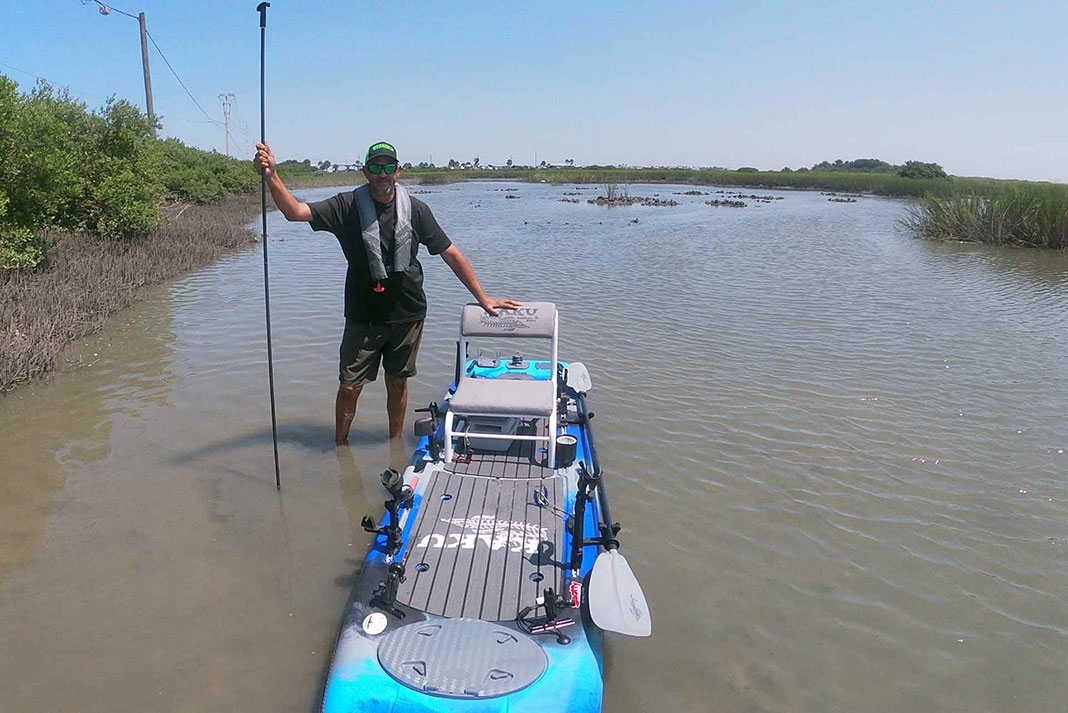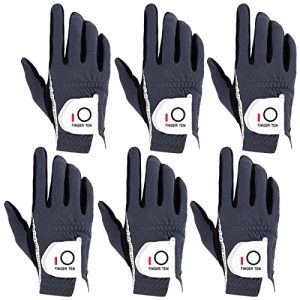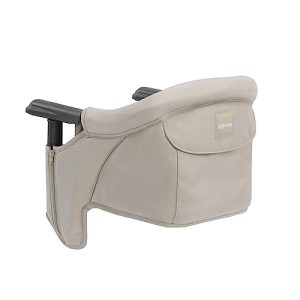Contents
- Choosing the Right Stakeout Pole
- Mastering Basic Stakeout Pole Technique
- Advanced Stakeout Pole Techniques
- Enhancing Kayak Stability for Stakeout Fishing
- Safety Precautions for Stakeout Fishing
- Strategies for Effective Fishing with Stakeout Pole
- Choosing the Right Gear for Stakeout Fishing
- Tips for Efficient Paddling Technique during Stakeout Fishing
- Maintaining and Caring for Your Stakeout Pole
- Benefits and Advantages of Stakeout Pole Fishing
Are you a fishing enthusiast looking to enhance your kayak fishing skills? Look no further! In this article, we will explore the art of stakeout pole technique in kayak fishing. With the help of a stakeout pole, you can perfect your positioning on the water, allowing for better stability and improved fishing opportunities. Join us as we delve into the world of kayak fishing and discover the secret to mastering this effective technique. Get ready to take your fishing game to the next level!
Choosing the Right Stakeout Pole
When it comes to stakeout fishing from your kayak, choosing the right stakeout pole is crucial. There are various factors to consider, such as the fishing environment, performance features, optimal length, and material and weight of the pole. By taking these into account, you can ensure a successful and enjoyable stakeout fishing experience.
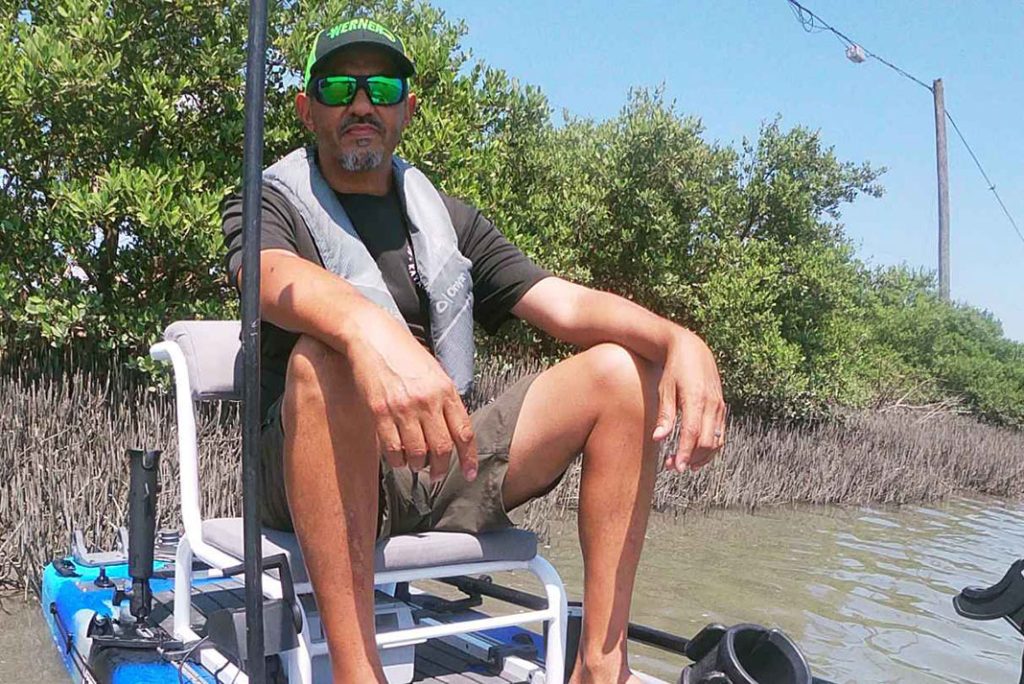
Consider Your Fishing Environment
Before selecting a stakeout pole, it’s important to consider the fishing environment you’ll be navigating. Are you planning to fish in calm lakes, fast-moving rivers, or coastal areas with strong tides? Each environment calls for different stakeout pole characteristics.
For calm lakes, a shorter stakeout pole may be sufficient to keep your kayak in place. However, if you’re planning to fish in rivers or coastal areas with more challenging conditions, you’ll need a longer and sturdier stakeout pole to handle the stronger currents or tides. Evaluating your fishing environment will help you determine the necessary length and strength of the pole.
Evaluate Performance Features
When choosing a stakeout pole, it’s essential to evaluate its performance features. Look for a pole with a sharpened tip that easily penetrates various types of bottom surfaces, such as sand, mud, or rocky terrain. This will ensure a secure hold when anchoring your kayak.
Additionally, consider the pole’s grip handle. Look for a comfortable and non-slip handle that allows for a firm grip, even in wet conditions. A pole with a contoured handle will also prevent hand fatigue during long stakeout fishing sessions.
Other performance features to consider include the pole’s durability, adjustability, and ease of use. Opting for a stakeout pole that is made of high-quality materials and has a reliable locking mechanism will ensure its longevity and enhance your overall fishing experience.
Optimal Length
The length of your stakeout pole is directly related to the fishing environment and the size of your kayak. Longer poles, typically ranging from 6 to 8 feet, are ideal for navigating rivers or coastal areas with stronger currents or tides. These longer poles will anchor your kayak more securely, providing stability in challenging conditions.
On the other hand, if you plan to fish in smaller bodies of water, such as ponds or calm lakes, a shorter stakeout pole, around 4 to 6 feet, may be more suitable. These poles are easier to handle and provide enough stability for these less demanding environments.
Keep in mind that a stakeout pole that is too long can become unwieldy, while one that is too short may not provide enough stability. Finding the optimal length tailored to your fishing environment and kayak size is essential for effective stakeout fishing.
Material and Weight
The material and weight of the stakeout pole are significant considerations, as they directly affect its durability, portability, and ease of use. Most stakeout poles are made of either fiberglass or aluminum.
Fiberglass poles are known for their strength and flexibility. They offer excellent longevity, even when used in challenging conditions. However, fiberglass poles can be heavier than their aluminum counterparts, which may affect ease of transportation and maneuverability.
Aluminum poles, on the other hand, are lightweight and corrosion-resistant. They are easier to carry, making them ideal for anglers who frequently hike to their fishing spots. However, aluminum poles may be less sturdy and may not provide as firm of an anchor hold in strong currents or tides.
Ultimately, the material and weight of the stakeout pole depend on your personal preferences and fishing environment. Consider factors such as durability, portability, and strength to select the most suitable option for your needs.
Mastering Basic Stakeout Pole Technique
Once you’ve selected the perfect stakeout pole for your fishing adventures, it’s time to master the basic techniques. Understanding anchoring principles, proper placement of the stakeout pole, and maintaining stability and balance are key to successful stakeout fishing.
Understanding Anchoring Principles
To effectively use a stakeout pole, it’s essential to understand the principles of anchoring. When you anchor your kayak with a stakeout pole, the pole’s tip should penetrate the bottom surface and hold your kayak in place against the forces of wind, current, and waves.
To achieve a secure hold, position the stakeout pole at a slight angle towards the bow of your kayak, allowing it to dig into the bottom. Applying gentle pressure on the pole while keeping consistent tension will ensure a secure anchorage.
Proper Placement of the Stakeout Pole
Placing the stakeout pole in the right location on your kayak is crucial for stability and balance throughout your stakeout fishing activities. Find a spot near the rear of your kayak, ensuring that the pole’s handle is within your reach.
Before inserting the pole into the water, make sure to position it on the side opposite to the prevailing wind or current. This will help counteract the forces trying to push your kayak off balance and keep it aligned with your desired fishing location.
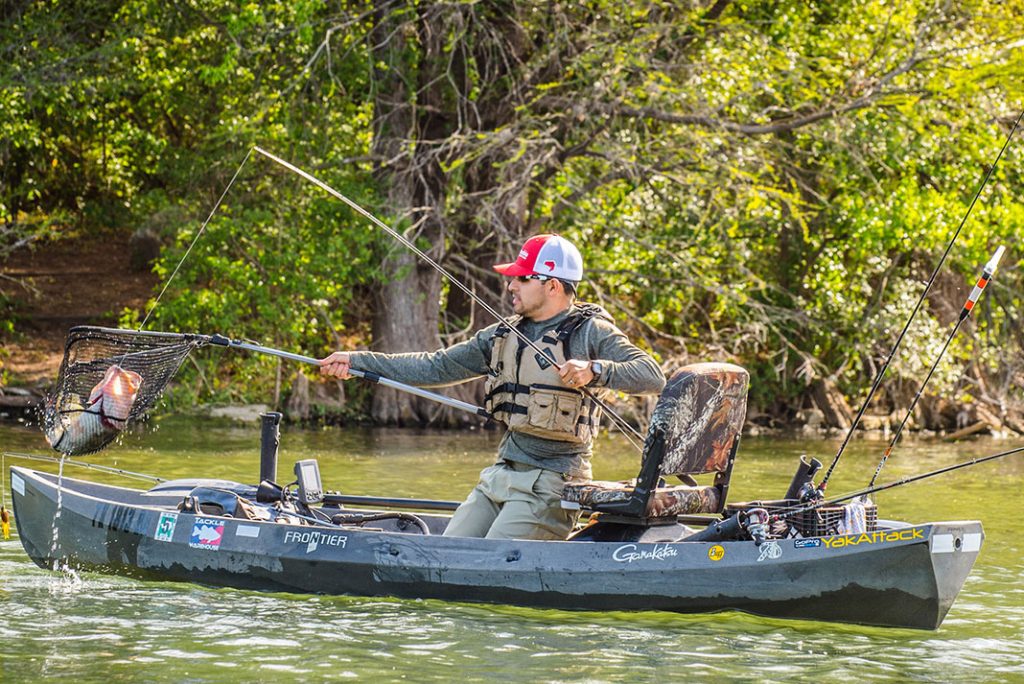
Maintaining Stability and Balance
To maintain stability and balance while using a stakeout pole, it’s important to distribute your weight evenly in the kayak. Position yourself towards the middle or slightly towards the rear of the kayak, allowing for better weight distribution.
Keep your body centered, and avoid making sudden movements that can upset your kayak’s balance. Minimizing excessive leaning or shifting of weight will help you maintain stability and reduce the risk of capsizing.
Additionally, consider using kayak stabilizers or outriggers to provide extra stability during stakeout fishing. These attachments can further enhance your balance and prevent your kayak from tipping over when casting or reeling in a fish.
By mastering basic stakeout pole techniques, you’ll be well-prepared to anchor your kayak securely and enjoy a stable fishing platform. With practice, these techniques will become second nature, allowing you to focus on reeling in your next big catch.
Advanced Stakeout Pole Techniques
Once you’ve mastered the basics of stakeout fishing, it’s time to take your skills to the next level. Advanced techniques such as adjusting for wind and current, utilizing pole extensions, effectively navigating shallow waters, and safely maneuvering around obstacles can significantly enhance your stakeout fishing experience.
Adjusting for Wind and Current
As an experienced stakeout angler, you’ll inevitably encounter varying wind and current conditions. To effectively adjust for these factors, consider how they may affect the position and stability of your kayak.
When faced with strong winds, it’s important to position the stakeout pole closer to the bow of your kayak to minimize the chance of your kayak being blown sideways. The stakeout pole acts as a pivot point, allowing your kayak to align parallel to the wind for better stability.
For stronger currents, adjust the angle of your stakeout pole to counteract the force pushing your kayak downstream. By angling the pole slightly upstream, you can maintain your desired fishing position without being carried away by the current.
Utilizing Pole Extensions
In certain fishing situations, a standard length stakeout pole may not provide enough depth for anchoring your kayak securely. This is where pole extensions come in handy. Pole extensions allow you to increase the depth at which your stakeout pole penetrates the bottom surface, ensuring a more stable anchorage.
When using a pole extension, make sure it securely attaches to your stakeout pole and remains stable. Test the extension’s stability before relying on it in challenging fishing conditions. With a reliable pole extension, you can confidently anchor your kayak even in deeper waters or areas with soft bottoms.
Effectively Navigating Shallow Waters
One of the biggest advantages of stakeout fishing is the ability to navigate shallow waters that are inaccessible to larger boats. However, navigating these shallow areas requires finesse and precision.
To effectively navigate shallow waters, pay close attention to the position of the stakeout pole. In water bodies with sandy or muddy bottoms, it’s crucial to position the pole in denser areas to ensure a more secure hold. Avoid areas with softer bottoms that may not provide enough stability.
Additionally, paddle with care to avoid disturbing the bottom or getting stuck in vegetation. Using shorter paddle strokes and lifting your paddle out of the water will minimize disturbance and reduce the risk of getting caught.
Safely Maneuvering Around Obstacles
During stakeout fishing, you may encounter various obstacles such as rocks, fallen trees, or dense vegetation. It’s important to navigate around these obstacles safely to avoid damaging your kayak and risking injury.
When approaching an obstacle, evaluate its proximity and determine the best course of action. If possible, carefully move around it, ensuring you maintain balance and stability. In some cases, you may need to retract the stakeout pole temporarily to navigate tight spaces or avoid potential damage.
Always maintain a cautious approach when maneuvering around obstacles and prioritize your safety. By being mindful of your surroundings and making calculated decisions, you can navigate challenging fishing spots while minimizing risks.
Enhancing Kayak Stability for Stakeout Fishing
While using a stakeout pole provides stability to your kayak, there are additional steps you can take to enhance its overall stability. Choosing a stable kayak design, adding outriggers or stabilizers, optimizing weight distribution, and improving paddling skills are all effective ways to enhance your kayak’s stability for stakeout fishing.
Choosing a Stable Kayak Design
When selecting a kayak for stakeout fishing, opt for a stable design that minimizes the risk of tipping over. Look for kayaks with a wider hull, flat bottom, and ample primary stability. These features will provide a solid foundation for stability during stakeout fishing activities.
Sit-on-top kayaks are a popular choice for stakeout fishing due to their inherent stability. They offer a wide and open cockpit, allowing for easy movement and improved balance. Additionally, sit-on-top kayaks provide better drainage and self-bailing capabilities, making them suitable for fishing in various water conditions.
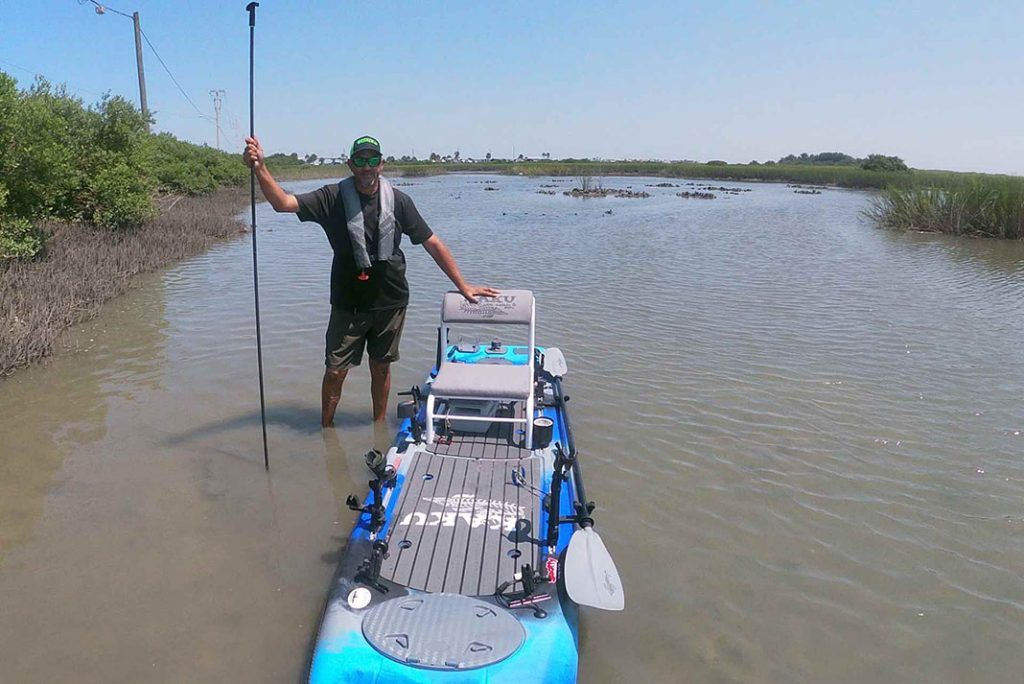
Adding Outriggers or Stabilizers
For anglers seeking extra stability, attaching outriggers or stabilizers to their kayak can be a game-changer. Outriggers are floatation devices attached to the sides of a kayak, increasing stability and preventing tipping. They work by providing additional buoyancy to counteract the weight and movements of the angler.
Stabilizers, on the other hand, are attachments that extend from the sides of the kayak below the waterline. They function similarly to outriggers but are more streamlined, allowing for easier maneuverability in narrow fishing spots. Stabilizers provide lateral stability, making them an excellent choice for anglers who frequently fish in shallow or weedy areas.
Both outriggers and stabilizers enhance kayak stability, allowing for more confidence and security while using a stakeout pole. Consider your fishing preferences and the specific conditions you encounter to determine which option is best suited for you.
Optimizing Weight Distribution
Proper weight distribution within your kayak is essential for stability during stakeout fishing. Uneven weight distribution can create imbalances, making it challenging to maintain stability and balance.
When loading your kayak with fishing gear and equipment, aim to evenly distribute the weight throughout the kayak’s length. Place heavier items closer to the center, keeping the kayak balanced. This will help prevent the kayak from tilting to one side and improve its overall stability.
By optimizing weight distribution, you’ll minimize the risk of capsizing and ensure a more stable platform for stakeout fishing.
Improving Paddling Skills to Reduce Movement
During stakeout fishing, it’s important to minimize unnecessary movements that may create instability or scare away fish. By improving your paddling skills, you can reduce excessive kayak movements and disturbances.
Practice efficient paddle strokes, focusing on smooth and controlled movements. Minimize the splashing and splattering of water by carefully entering and exiting the water with your paddle. These small adjustments will reduce the chances of startling nearby fish or disturbing the tranquility of your fishing spot.
Additionally, consider using a paddle leash to secure your paddle while using the stakeout pole. This ensures that your paddle remains within reach but doesn’t contribute to unnecessary movements or disturbances.
By enhancing your kayak stability through design choices, attachments, weight distribution, and improved paddling techniques, you can create an optimal fishing platform for stakeout fishing. A stable kayak allows you to focus on perfecting your fishing techniques and enjoying the serenity of the water.
Safety Precautions for Stakeout Fishing
While stakeout fishing provides an enjoyable and serene fishing experience, it’s essential to prioritize safety. By following a few safety precautions, you can minimize risks and ensure a safe and enjoyable time on the water.
Using Reflective Gear and Visibility Aids
Whether you’re fishing during daylight hours or at twilight, it’s crucial to make yourself visible to other watercraft. Using reflective gear, such as a high-visibility life jacket or a reflective paddle, will increase your visibility and reduce the risk of collisions.
Consider attaching reflective tape or stickers to your kayak, especially on the sides and rear, to enhance your visibility from various angles. These simple additions can greatly improve your safety, especially when fishing in areas with heavy boat traffic.
Additionally, invest in a good-quality kayak light or navigation lights if you plan to fish during low-light conditions. These lights not only illuminate your path but also make you more visible to other boaters, ensuring a safer stakeout fishing experience.
Securing Anchor Tethers and Lines
Properly securing anchor tethers and lines is vital for safety during stakeout fishing. Ensure that your anchor line is firmly attached to the stakeout pole and your kayak. A loose or improperly secured anchor line can pose a significant hazard, potentially causing entanglement or capsizing.
Regularly inspect your anchor lines and tethers for signs of wear or fraying. Replace any damaged components to maintain the integrity and safety of your stakeout fishing setup.
Monitoring Weather and Tidal Conditions
Before heading out for a stakeout fishing trip, always check weather and tidal conditions. Sudden changes in weather or strong tidal currents can increase risks while on the water.
Make use of weather forecast tools, such as smartphone apps or marine forecast websites, to stay informed about potential storm fronts, high winds, or rapid changes in tide. If unfavorable conditions are predicted, consider rescheduling your stakeout fishing trip for a safer time.
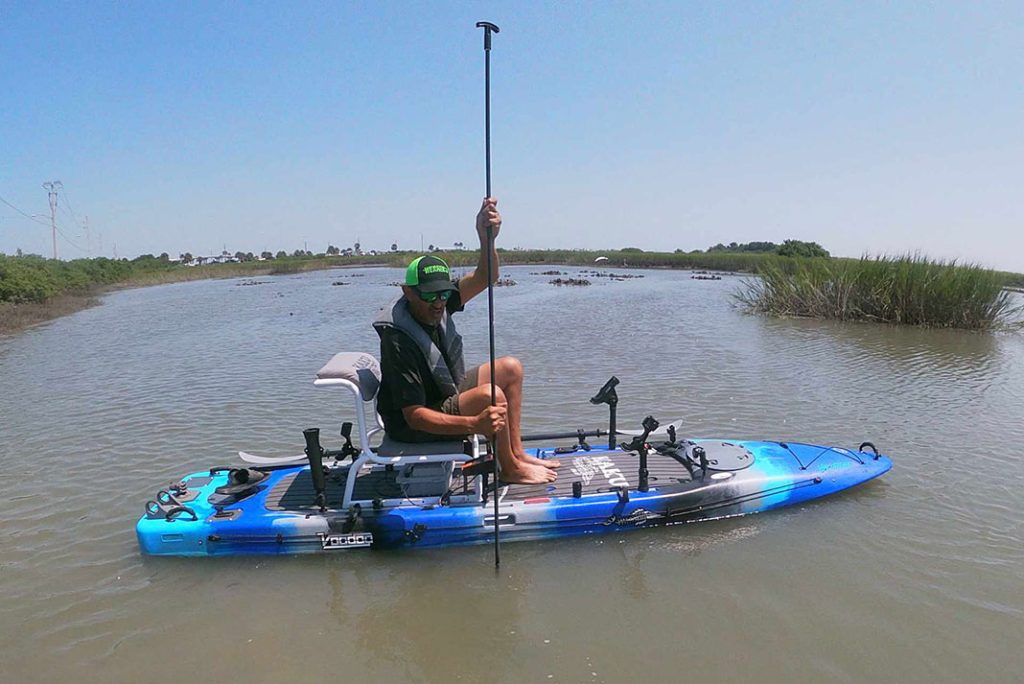
Avoiding Overexertion and Fatigue
Stakeout fishing can be physically demanding, requiring extended periods of sitting or standing in one position. It’s crucial to listen to your body and avoid overexertion or fatigue, which can lead to accidents or health issues.
Take regular breaks to stretch your muscles and prevent stiffness or cramping. Stay hydrated and nourished to maintain energy levels throughout your fishing session. It’s also important to dress appropriately for the weather to prevent overheating or exposure to cold temperatures.
By prioritizing safety and taking the necessary precautions, you can enjoy a worry-free stakeout fishing experience. Remember, it’s always better to err on the side of caution and ensure your well-being while on the water.
Strategies for Effective Fishing with Stakeout Pole
Stakeout fishing offers unique advantages, allowing anglers to access hard-to-reach fishing locations and benefit from a silent approach. By implementing effective strategies, you can optimize your stakeout fishing experience and increase your chances of landing a successful catch.
Identifying Productive Fishing Locations
To make the most of your stakeout fishing adventures, it’s important to identify productive fishing locations. Research your chosen fishing spot thoroughly, gathering information about the fish species present, their preferred habitats, and feeding patterns.
Look for areas with structures that attract fish, such as submerged logs, weed beds, or rocky outcrops. These structures provide shelter and serve as feeding grounds, increasing your chances of encountering active fish.
When scouting for productive fishing locations, pay attention to visible signs of fish activity, such as feeding birds, jumping fish, or surface disturbances. These indicators often point to areas where fish are actively feeding, giving you a higher chance of success.
Maximizing Stealth and Quietness
Silence and stealth are crucial when stakeout fishing, as sudden noises or movements can scare fish away. When positioning your stakeout pole and engaging in fishing activities, prioritize quietness and minimize unnecessary disturbances.
Avoid loud conversations or sudden movements that may create vibrations in the water. Use soft and controlled movements when casting or adjusting your fishing gear. By being mindful of your actions and maintaining a quiet approach, you’ll increase your chances of getting close to fish without alarming them.
Utilizing the Stakeout Pole as a Rod Holder
One of the advantages of stakeout fishing is the convenience of using the stakeout pole as a rod holder. By securely placing your fishing rod in the pole’s handle, you can free up your hands and engage in other activities while waiting for a bite.
Make sure to position the rod securely in the pole’s handle to prevent it from sliding or falling overboard. Double-check the stability of the setup before stepping away from your fishing rod.
Utilizing the stakeout pole as a rod holder allows you to multitask, such as preparing bait, taking a snack break, or simply enjoying the scenery. This hands-free operation ensures that you don’t miss any action while keeping your fishing setup secure and accessible.
Adapting to Changing Fishing Conditions
Fishing conditions can change throughout the day, requiring you to adapt your strategies accordingly. Be observant and responsive to these changes to maximize your stakeout fishing success.
Pay attention to variables such as weather patterns, wind speed and direction, and fish behavior. If the wind direction shifts, reposition your stakeout pole to maintain a steady fishing position. Similarly, if fish activity slows down in one specific area, move to another location or adjust your bait presentation to entice them.
Being adaptable and willing to change your approach will greatly enhance your stakeout fishing experience. Stay open-minded, and don’t hesitate to experiment with different techniques or fishing spots to increase your chances of success.
Choosing the Right Gear for Stakeout Fishing
Selecting the right gear for stakeout fishing is crucial for a successful and enjoyable experience on the water. Whether it’s choosing the proper fishing rod, selecting the right line and leader, using essential fishing accessories, or organizing your tackle and equipment, each aspect contributes to the efficiency and effectiveness of your stakeout fishing endeavors.
Selecting the Proper Fishing Rod
When selecting a fishing rod for stakeout fishing, consider the targeted fish species, fishing techniques, and your personal preferences. Different fishing rods are designed to excel in specific situations, so it’s important to match your rod to your fishing needs.
Choose a rod with the appropriate power and action for the fish you plan to catch. Lighter power rods are suitable for smaller fish species, while heavier power rods are better equipped to handle larger or more aggressive fish. The rod’s action, which determines its flexibility, should match your preferred fishing technique, whether it’s finesse fishing or power casting.
Additionally, consider the material and construction of the fishing rod. Graphite rods are lightweight and responsive, while fiberglass rods offer durability and strength. Select a rod that suits your fishing style and budget, ensuring it provides the necessary sensitivity and control for stakeout fishing.

Choosing the Right Line and Leader
Choosing the right line and leader is crucial for successful stakeout fishing. The choice of fishing line depends on various factors such as the target species, fishing technique, and water conditions.
Monofilament lines are versatile and offer good knot strength, making them a popular choice for stakeout fishing. They have excellent abrasion resistance and are suitable for both freshwater and saltwater fishing. Braided lines, on the other hand, offer high strength and sensitivity, making them ideal for detecting subtle bites. They are also thinner in diameter, allowing for longer casts.
For leaders, fluorocarbon is often the preferred choice due to its low visibility underwater. Fluorocarbon leaders are less likely to spook fish, giving you a better chance of landing a catch. Combine the appropriate line and leader to ensure the best chances of success during stakeout fishing.
Using Essential Fishing Accessories
Having the right fishing accessories on hand can greatly enhance your stakeout fishing experience. Consider carrying essentials such as a fishing net, pliers, line cutter, and a tackle storage system.
A fishing net is essential for safely landing fish and minimizing the risk of losing them while attempting to bring them into the kayak. Choose a net with a proper netting material and size that matches the fish species you’re targeting.
Pliers and a line cutter are essential tools for hook removal and line management. They will allow you to handle fish safely and efficiently, reducing stress on the fish and ensuring a smooth release.
Investing in a tackle storage system, such as a tackle box or tackle bag, will keep your fishing gear organized and easily accessible. Having your tackle organized and within reach saves time and ensures you can quickly change lures or rigs when needed.
Storing and Organizing Tackle and Equipment
Proper storage and organization of your tackle and equipment are essential for a hassle-free stakeout fishing experience. Consider investing in a tackle crate or kayak-specific storage system that offers ample space for your fishing gear.
Arrange your tackle by category, such as hooks, sinkers, and lures, to quickly locate what you need. Use tackle trays or small containers within your storage system to keep items separate and prevent tangling or damage.
Organize your equipment, such as stakeout poles, anchor lines, and fishing rods, to maximize space and prevent entanglement. Utilize bungee cords or adjustable straps to secure items in place during transportation or when not in use.
By selecting the right gear, utilizing essential accessories, and keeping your tackle and equipment organized, you can enjoy a seamless and efficient stakeout fishing experience without the frustration of tangled lines or missing gear.
Tips for Efficient Paddling Technique during Stakeout Fishing
Efficient paddling technique is essential during stakeout fishing to minimize kayak movements, maintain control, and conserve energy. By mastering proper paddle strokes, adjusting for wind and current, minimizing kayak movement and disturbance, and avoiding fatigue, you can optimize your paddling experience and focus on successful fishing.
Maintaining Control and Momentum
Maintaining control and momentum while paddling is essential for efficient stakeout fishing. Focus on developing a smooth and controlled paddling rhythm, ensuring that each stroke propels your kayak forward with minimal deviation.
Keep your strokes close to the kayak, avoiding wide or sweeping motions that can cause excessive lateral movement. Engage your core muscles to generate power, allowing for efficient navigation through the water.
Paddling Against Wind and Current
In challenging conditions, such as windy or fast-moving water, paddling against wind and current requires proper technique and adjustments. To paddle against the wind, angle your paddle blades to catch the wind less, reducing resistance and maximizing forward motion.
When paddling against a strong current, use shorter, quicker paddle strokes to maintain control. Position your paddle at a slight angle towards the bow and engage your core muscles to power through the water.
Minimizing Kayak Movement and Disturbance
During stakeout fishing, minimizing kayak movement and disturbance is crucial to avoid alerting nearby fish. By reducing unnecessary movements, you increase your chances of landing a successful catch.
Avoid excessive leaning or shifting of weight that can create instability and unnecessary movement. Keep your body centered and stable, ensuring your kayak remains balanced and quiet.
Consider using a paddle leash to secure your paddle while using the stakeout pole. This eliminates the need to hold onto the paddle constantly, reducing excess movement and disturbances caused by paddle placement or retrieval.
Avoiding Fatigue and Maximizing Endurance
Stakeout fishing often involves extended periods of paddling and remaining stationary while using the stakeout pole. To avoid fatigue and maximize endurance, it’s important to listen to your body and practice proper paddling ergonomics.
Take regular breaks to stretch and relax your muscles. Utilize proper paddling technique, engaging your core muscles for efficient propulsion rather than relying solely on your arms and shoulders. This will help distribute the workload and reduce the chances of fatigue or overexertion.
Additionally, work on building your endurance through regular paddling exercises or conditioning activities. Strengthening your core muscles and improving cardiovascular fitness will contribute to your overall stamina during stakeout fishing.
By implementing efficient paddling techniques, adjusting for wind and current, minimizing kayak movement, and avoiding fatigue, you can optimize your paddling experience while enjoying an extended stakeout fishing session.
Maintaining and Caring for Your Stakeout Pole
Proper maintenance and care of your stakeout pole will ensure its longevity and reliable performance. Regularly cleaning and preventing corrosion, storing and transporting the pole correctly, inspecting for potential damages, and replacing worn-out parts are essential steps to maintain your stakeout pole in optimal condition.
Cleaning and Preventing Corrosion
Saltwater and other environmental factors can contribute to the corrosion of your stakeout pole. To prevent corrosion and maximize its lifespan, rinse off your stakeout pole with freshwater after each fishing session, paying close attention to the pole’s exposed metal parts.
Use a soft bristle brush to gently remove any dirt or debris that may have accumulated on the pole’s surface. Avoid using abrasive cleaning agents or brushes that may scratch or damage the pole’s outer layer.
For added protection, consider applying a thin layer of corrosion-resistant oil or lubricant to the pole’s metal components. This will create a barrier against moisture and saltwater, reducing the chances of corrosion.
Proper Storage and Transportation
Properly storing and transporting your stakeout pole is essential to prevent damage and ensure its longevity. When not in use, store the pole in a cool and dry location, away from direct sunlight and extreme temperature fluctuations. Ensure that the pole is not under prolonged pressure or stress, as this can cause deformation or weakening.
When transporting the stakeout pole, use a secure storage system or bag designed specifically for stakeout poles. These storage systems provide protection against accidental impacts and minimize the risk of damage during transportation.
Avoid placing heavy objects on top of the pole or subjecting it to excessive force or pressure. Handle the pole with care, especially when securing it to your kayak or when entering or exiting the water.
Inspecting and Repairing Potential Damages
Regularly inspect your stakeout pole for any signs of wear and tear or potential damages. Check for cracks, splintering, or loose components, paying close attention to the pole’s joint areas and locking mechanisms.
If you detect any damages, determine whether they can be repaired or if the pole requires replacement parts. In some cases, minor damages can be fixed with the appropriate adhesive or replacement components provided by the manufacturer.
However, if the pole’s structural integrity is compromised, it’s crucial to replace it immediately. Damaged poles can break under pressure, posing a safety risk while on the water.
Replacing Worn-out Parts
Certain parts of a stakeout pole may wear out over time due to prolonged use or exposure to harsh conditions. Frequently inspect the pole’s components, such as the grip handle, locking mechanisms, and tip, for signs of wear or deterioration.
Replace any parts that show significant wear, rust, or damage to ensure proper functioning of the stakeout pole. Ignoring worn-out parts can compromise the pole’s stability and performance, increasing the risk of an anchoring failure.
By maintaining and caring for your stakeout pole through regular cleaning, proper storage and transportation, inspection for damages, and timely replacement of worn-out parts, you can extend the lifespan of your pole and continue enjoying its reliable performance for many stakeout fishing adventures to come.
Benefits and Advantages of Stakeout Pole Fishing
Stakeout pole fishing offers numerous benefits and advantages compared to other angling techniques. These advantages include improved casting accuracy and placement, a silent fishing approach, versatility in shallow water fishing, and hands-free operation for multi-tasking while on the water.
Improved Casting Accuracy and Placement
One of the primary advantages of stakeout pole fishing is the improved casting accuracy and placement it offers. By firmly anchoring your kayak with a stakeout pole, you’re able to maintain a fixed position, allowing for precise targeting of specific fishing spots.
Stakeout fishing eliminates the need to constantly adjust your kayak’s position using paddling or pedal-propelled methods. With a stationary platform, you can focus on casting your bait or lure precisely to your desired spot, increasing your chances of attracting fish and enticing them to bite.
Silent Fishing Approach
Another significant advantage of stakeout pole fishing is the silent fishing approach it allows. Unlike noisy motorized boats, kayaks offer a quiet and non-disruptive mode of transportation on the water. Pairing the stealth of a kayak with the stability of a stakeout pole creates an optimal fishing platform that won’t alarm nearby fish.
The ability to move quietly through the water and refrain from making loud disturbances significantly increases your chances of success. Fish are less likely to be spooked by any unnatural sounds or vibrations, increasing the likelihood of bites and successful catches.
Versatility for Shallow Water Fishing
Stakeout fishing excels in shallow water environments, providing access to areas that may be inaccessible or challenging for larger boats. The shallow draft of a kayak, coupled with the precise anchoring ability of a stakeout pole, allows anglers to navigate through densely vegetated, rocky, or narrow channels with ease.
These shallow water environments are often teeming with fish, as they serve as nurseries for juvenile fish or offer abundant food sources. By using a stakeout pole, you can position your kayak over these productive areas, increasing your chances of landing a successful catch.
Hands-Free Operation for Multi-Tasking
Stakeout pole fishing provides anglers with a unique hands-free fishing experience. By securely anchoring your kayak, you can engage in various fishing-related tasks without needing to hold onto your paddle or worry about drifting away.
This hands-free operation allows you to multitask, such as preparing bait, adjusting your fishing gear, checking your phone for fishing apps, or simply enjoying a snack while waiting for a bite. The freedom to focus on multiple tasks simultaneously improves efficiency and enjoyment during stakeout fishing.
Overall, stakeout pole fishing offers numerous advantages for anglers, including improved casting accuracy, a silent fishing approach, versatility in shallow water fishing, and the freedom to multitask. These benefits make stakeout fishing a highly effective and enjoyable angling technique for kayak anglers of all skill levels.

